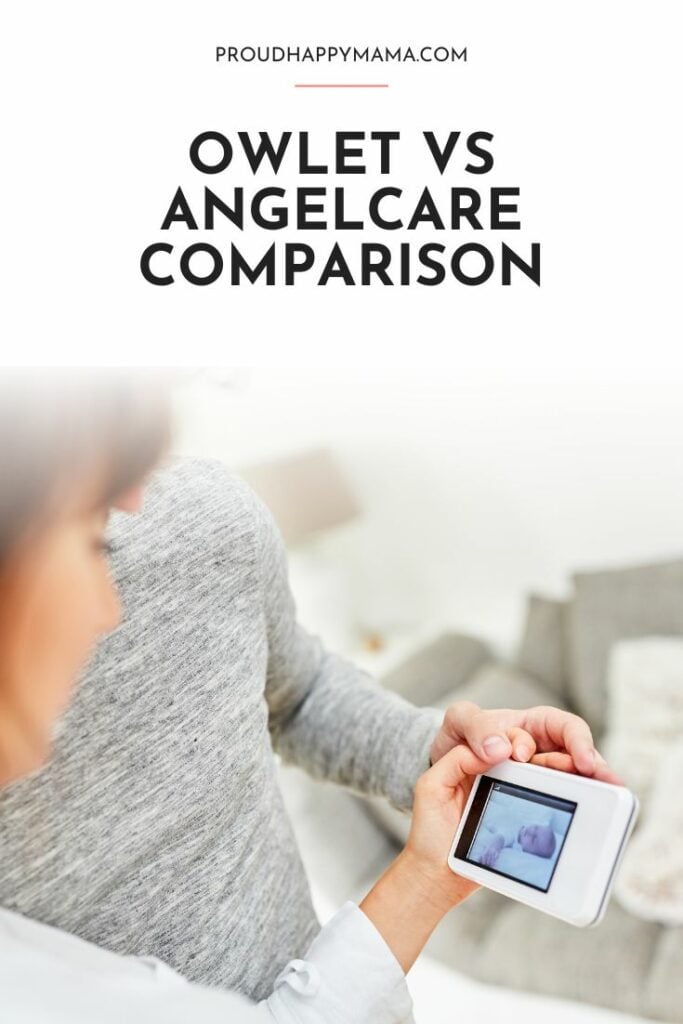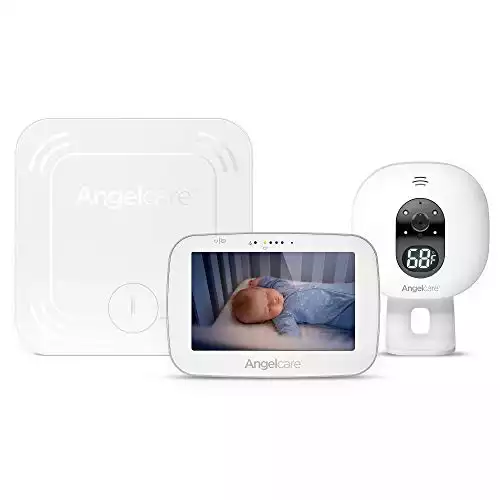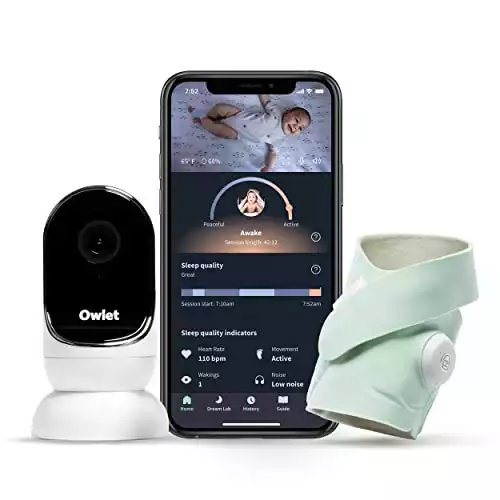Owlet Vs Angelcare
Trying to figure out what the difference is between Owlet vs Angelcare baby monitors?
Then let us help you decide which baby monitor will be best for you and your baby with our Angelcare vs Owlet comparison guide.
As relaxing as nap time should be, many new parents often find it’s the exact opposite.
Having finally encouraged your baby to sleep, we discover it’s impossible to leave them alone.
After all, how can we know they’re safe if we aren’t watching them?
Baby monitors give parents a chance to relax, so they can stay aware of their child’s comfort, without needing to hover over the crib.
And technological advancements have made monitors better than ever, alerting parents to problems even faster than cries can.
Angelcare and Owlet are two brands at the forefront of the baby monitor revolution. But which brand is right for you?
Read on as we look at functionality, versatility, durability, and cost so you can easily decide which one is right for you.
And if you love this guide on Angelcare monitor vs Owlet, then make sure to also check out these guides on Nanit vs Owlet, Snuza vs Owlet, and best baby monitors for more great baby monitor options!
This post contains affiliate links. See our full disclosure here
Owlet vs angelcare
Let’s dive in and look at the key differences between the Owlet sock vs Angelcare!
All About Angelcare
Angelcare is based on the traditional baby monitoring system, but updated with the latest in motion detector technology.
The basics of the Angelcare system is the motion sensor pad and the alert monitor. The sensor pad is placed beneath the mattress and tracks movement, alerting parents when the child has been completely still for 20 seconds.
The system can be combined with a camera, to operate as a traditional monitor, or used as a more simple alert system.
The unit also integrates with other baby monitors, which is worth considering if you want high quality video.
Features that parents love about Angelcare that make it an excellent option.
- The Wireless Baby Movement Sensor Pad comes with 4 adjustable sensitivity levels so you can adjust it as your baby grows.
- The 5’’ touchscreen Parent Unit allows you to see your baby days and night.
- Two way talk-back.
- The Angelcare can also make an audible “tick” noise as your baby breathes, for extra peace of mind.
- The AC527 can also be used without the movement detection for those early toddler years.
Pros
- Able to be used with multiple devices
- Easy to set up
- High quality video and audio
- Wireless breathing monitor works great with no-contact to baby
- Parent unit has large screen with good quality
- Night vision works well
- Includes wall mount and table top stand
Cons
- Sensor pad can be hard to place
- Forgetting about the breathing monitor can lead to some startling false alarms in the middle of the night
- No app available
All About Owlet
Owlet is a new take on the baby monitor, using wearable technology to provide parents with real time updates on the health of their baby.
The heart of the Owlet system is their Dream Sock, a simple device that allows parents to track their child’s well-being as they sleep.
The Dream Sock detects heart rate, oxygen level, and sleep, notifying you when it detects a problem.
This can also be combined with the Owlet baby monitor camera, which provides two-way audio, HD 1080p video, and monitored notifications.
Features that parents love about Owlet that make it an excellent option.
- Parents are about to track their baby’s heart rate, oxygen level and sleep trends while streaming HD video.
- You can view your baby’s readings in real time on your smartphone as well a review a detailed 7-day wellness history.
- Owlet uses encryption to keep your data safe.
- The wireless camera comes with night vision, wide-angle view, 4X zoom, room temperature tracking, 2 way talk, and background audio.
- Parents receive sound and motion notifications from the camera that alert them if Baby is crying or moving whilst the Smart Sock notifies them is their baby’s readings leave “safe” zones so you can know when your baby really needs you.
Pros
- 3 sock sizes to suit a growing baby
- Able to be used with multiple devices
- Easy to set up
- Wi-Fi Camera and HD video
- Detailed tracking including vitals such as oxygen level, heart rate and total hours slept
- 7 day wellness reports
Cons
- Expensive
- Sock has to be worn
- No lighting options
- Not an external display
Similarities And Differences Between Angelcare vs Owlet
Wearable Tech
Both Angelcare and Owlet are non-contact monitoring that integrate a version of wearable tech into their system.
However, they both go about this in very different ways.
For a start, Angelcare doesn’t use traditional “wearable tech”, as you might think of it. Instead, the basis of Angelcare is a sort of mattress pad.
The Movement Sensor Pad is placed beneath your child’s mattress.
From here, it can sense even the smallest of movements, with three to four levels of tailored sensitivity (depending on the model).
When fifteen seconds have passed without recognized movement, a preliminary alarm sounds, to gently rouse the baby.
If after five seconds there’s still no movement detected, the parents are alerted.
The Angelcare system accurately monitors exactly what your baby is up to, and it does so without disturbing the child.
The Movement Sensor Pad slips beneath the mattress, and can’t be felt by sensitive babies.
Owlet uses more traditional wearable tech, made suitable for babies.
The Owlet Dream Sock is wrapped around the foot, and can monitor movement, sleep, and waking.
It also monitors heart rate and oxygen levels, building up a complex picture of your child’s health.
If an issue is sensed by the Dream Sock, an alert is sent to your phone, and you can check to see if everything is okay.
The Dream Sock wraps comfortably around the foot, and even the basic sock is suitable for up to 18 months.
For longer monitoring, the Dream Sock Plus can be used by children up to 5 years old.
The sock has to be charged before use, but it reaches a full charge in around 90 minutes. Linked with your smartphone, this is a really great portable monitor.
Most children seem to be happy wearing the Dream Sock, although some might find it takes a while to get used to the addition.
If your baby hates wearing shoes, you might have some Dream Sock tantrums to start!
Camera
Angelcare and Owlet are both slightly unusual in modern baby monitoring systems, as the camera isn’t a necessity.
If you want to save money, you can invest in an Angelcare motion sensor or Owlet sock, and support them with a low-cost monitor.
But if you want a complete system, you can pair your monitor with a matching camera.
The Angelcare camera and parent unit also track and indicate movement, as well as providing two-way audio for reassuring communication.
It also indicates room temperature, and offers Infrared Night Vision. The camera is fine, but not exceptional.
The resolution is only 480 x 272px, and the small lens doesn’t capture a wide field. It feels like an add-on, rather than an essential part of the design.
That said, it works well as an addition to the motion sensor, and means you can quickly check if you’ve received an alert.
Owlet, on the other hand, has clearly put a lot of thought into the camera. It doesn’t just feel like a handy add-on to the Dream Sock, but performs exceptionally on its own.
With 1080p HD video that streams over encrypted Wi-Fi, and incredibly clear night vision, this camera elevates the Owlet system.
A 130-degree wide angle lens and 4X zoom allows parents to monitor closely, while two-way audio offers a quick response.
And with a temperature and humidity sensor, you can really see how your little one is doing.
The Owlet is a clear winner when it comes to the camera, but the Angelcare does have an advantage of compatibility: the motion pad works with most monitors.
Reporting And Parent Units
Angelcare and Owlet use very different methods to report results to parents.
Angelcare has two options of reporting. First, there’s the basic alarm system. This isn’t linked to a camera, only to the sensor pad.
When no movement has been detected, the alarm sounds, and parents are alerted. It’s fairly basic, but it works to convey simple information.
Alternatively, you can purchase the camera and parent unit. This is a separate screen that streams video and audio, as well as showing basic data such as room temperature.
The unit will alert you if there’s been no movement, and you can check the video feed to see what’s happening.
The parent unit for the Angelcare is basic, showing reduced information over a reduced range. We think it’s standard for a baby monitor.
Owlet doesn’t use parent units. Instead, the information is streamed to your smartphone via the Owlet Dream app.
As well as streaming video and audio, this is where you’ll find the information gathered by the Dream Sock.
The app works with both camera and sock. As well as sharing the basic information, the app analyses data, and provides advice.
The advantage of a smartphone as the parent unit is that you don’t need to carry a second device with you. Your phone is generally always on hand, always charged, and provided an increased range. And best of all you can access it from any location such as work.
Plus, the added data of the Owlet really made the most of the app format.
Price
Angelcare is the less expensive choice. Even a complete bundle featuring camera, sensor, and parent unit costs less than just the Dream Sock from Owlet.
While neither option is particularly cheap, Angelcare is much more aligned with the cost of a standard baby monitor.
And if you have a camera unit already, the motion sensor pad and alarm is a reasonable price for sophisticated technology.
Owlet is a more premium service which is reflected in the price.
Final Thoughts on Owlet Sock vs Angelcare
It’s difficult to choose between Angelcare and Owlet, as they’re both so different.
Angelcare is less expensive, and offers a movement monitoring system that will reassure anxious parents.
We love that the movement sensor can be slipped under the mattress, and won’t disturb the baby, but the camera is a let-down.
It’s worth shopping around for a better camera, rather than relying on Angelcare.
Owlet, on the other hand, is incredibly advanced. We loved how easily the system fitted into everyday life, with the smartphone app being a real plus.
And as the sock is so small, this was a baby monitor with improved portability. However, the high cost can be prohibitive for new parents.
Overall, both units suit different needs. For improved health monitoring, invest in the Owlet. For quick reassurance, we recommend the Angelcare monitor.
We hope this guide has been helpful in helping you decide which is the right monitor for you and your baby.
And if you want to check out any more of our guides, we recommend checking out these guides on Miku vs Nanit, best non Wi-Fi baby monitors, best baby monitors with wifi, and best travel baby monitors!



